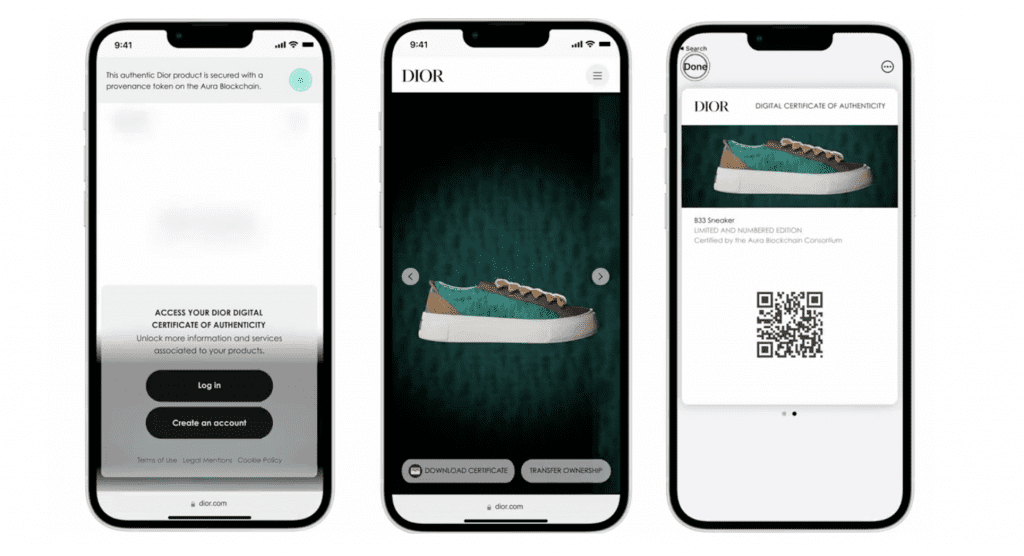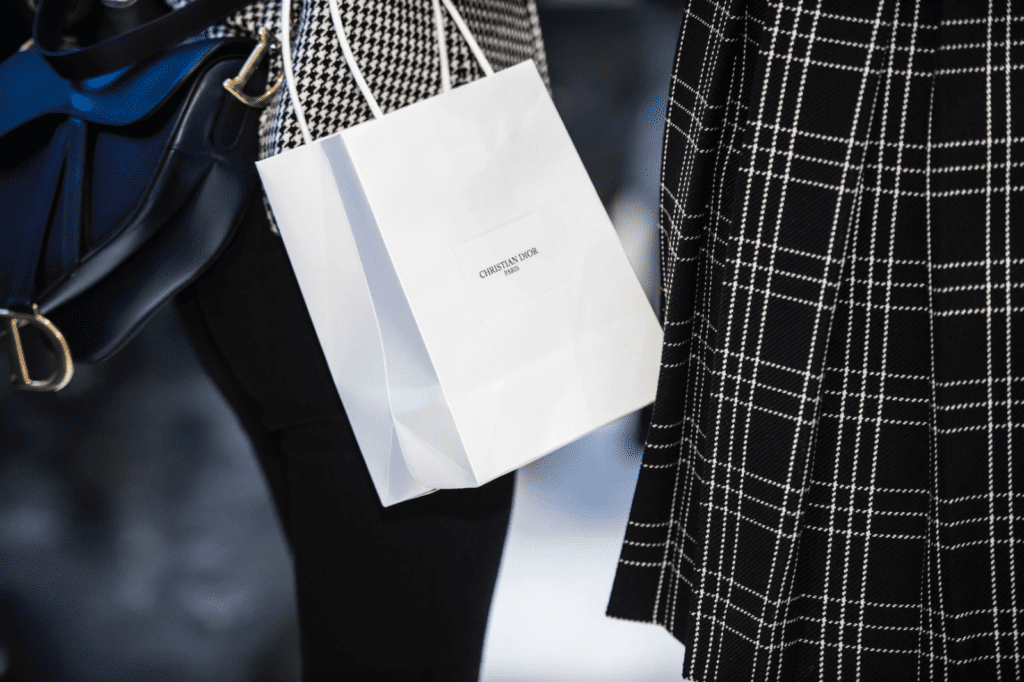Early this month, Dior unveiled the latest offerings from its B33 sneaker collection. In the lineup of different colored and textured offerings, one sneaker stands out: The limited-edition “Turquoise Dior Oblique mohair” pair comes equipped with a near-field communication – or “NFC” – chip, which allows the purchaser to “access to a platform to obtain [the] Digital Certificate of Authenticity” for the sneaker. Addressing the new tech-tied sneakers, Dior stated that for the first time in its history, each pair in this limited series of sneakers is “linked to its own Digital Twin, a unique and secure digital creation on the Ethereum blockchain” with the help of the Aura Blockchain Consortium’s Multi-Token Minter.
In addition to enabling buyers to ensure the authenticity of the sneakers via “Digital Certificate sof Authenticity,” Dior revealed that the corresponding digital twins – i.e., the virtual representation of an object that spans its lifecycle, is updated from real-time data, and uses simulation, machine learning and reasoning to help decision making – provide the limited-edition sneaker owners with “early-access and exclusive [Dior] perks starting with the Spring 2024 collection.”
For some context: As of the time of publication, only two sizes of the $1,350 sneakers were available on the LVMH-owned brand’s e-commerce site, and purchases of the sneakers are limited to 2 pairs per size per purchaser. The brand made a total of 470 pairs available.

Dior is, of course, not alone in rolling out (or at least thinking about) physical products that are tied to digital twin tech. The debut of its limited-edition B33 sneaker follows from the launch of digital Louis Vuitton trunks – which act as twins for physical versions – as part of the luxury giant’s VIA venture, for example.
One need not look further than a trademark application filed by Louis Vuitton in France on May 31, 2023 for “EMBRACING THE LEGACY OF OUR FUTURE” to get some insight into its efforts. The goods/services (in Class 35) consist of: the “organization, operation and supervision of customer loyalty programs in particular through programs offering consumers privileged access to acquire digital objects, authenticated or not by NFTs, namely bags, trunks, suitcases, etc.; organization, operation and supervision of customer loyalty programs in particular through programs offering consumers privileged access at physical events, online events or in virtual, AR or mixed reality environments; promotion of products and services through physical events, online or in virtual, AR or mixed reality environments organization and conduct trade fairs, fashion shows, events, and exhibitions in online or offline, virtual, AR or mixed reality environments, for commercial or advertising purposes; retail services for authenticated digital objects or not by NFTs, namely bags, trunks, suitcases, etc.;” among other things.
Meanwhile, Alo Yoga announced early this year that it would provide digital representations of its premium ski collection. (It is worth noting that the company stated at the time that it would not be “using [NFT] language,” and instead, would lean into “digital certificate of authenticity” in order to make it “feel natural to our community.”
At the same time, other companies, including Hermès and Tag Heuer, are clearly thinking about uses of digital twins within their own operations, as counsel for Hermès spoke to the potential use of digital twin technology to aid in the authentication of its sought-after handbags during the company’s trial against MetaBirkins creator Mason Rothschild. And Tag Heuer’s CEO Frédéric Arnault previously stated that he sees potential in “track[ing] products in the supply chain and then afterwards, selling those products with a digital twin,” hinting at further efforts in this realm by brands under the LVMH umbrella.
Given that digital twins can offer powerful insights for companies and perks for consumers, including token-gated benefits and loyalty/rewards-related offerings, chances are, more brands – in the fashion/retail industries and beyond – will follow suit. In fact, the demand for digital twin technology is expected to continue to escalate, with IMB data projecting that the value of the global digital twins market will reach $73.5 billion by 2027. Against that background, some of the potential legal issues posed by digital twins are worth reviewing.
“The risks posed by digital twins will differ depending on the nature of the digital twin and will need to be managed via the contract (or contracts) underpinning the digital twin,” Gilbert + Tobin’s Lesley Sutton, Simon Burns, Michael Caplan, Melissa Fai, Andrew Hii, Tim Gole, and Sheila McGregor stated in a note. Nonetheless, they point to the following as some of the key issues to consider – and questions that companies should ask themselves – in connection with any digital twin project …
Intellectual property rights: Does your digital twin use third party intellectual property rights? Do you have the right to use them in the digital twin as intended? If innovative new works are created in developing a digital twin, who owns the intellectual property in them?
Data use rights: Do you own the data you intend to use in your digital twin? If not, do you have authority from the owner of the data to use it in the digital twin as intended? This is a key consideration even with open-source data, which may be subject to usage limitations. The responsibility and authority of the data-providing parties and their financial rewards could become key negotiation points for digital twin projects.
Privacy & data protection: Even if you own data that could be useful in a digital twin, if it contains personal information collected from individuals, do you have their consent to use it in the way intended?
Cybersecurity: Data from mechanical sensors may present less risk from a privacy/data protection perspective, but increased connectivity brings the potential for increased security vulnerabilities. Who is responsible for keeping the data secure and who bears the risk of cyber events?
Malicious use: While the beneficial uses of digital twins are countless, they could also be used for malicious purposes, particularly where digital twins are made public. As an extreme example, digital twins could be used in ransomware or even terrorist attack planning to inflict maximum disruption or damage.
What protections are in place to protect against malicious use and who bears any resulting liability? With digital twins anticipated to become increasingly important for infrastructure and governance, malicious actors may in future target digital twins themselves.
Responsibility for data quality: How will you ensure that the data is accurate and who bears responsibility for ensuring data accuracy? If your digital twin is intended to model a mission-critical system, is the data you’re using fit for use in mission critical systems? This is particularly key if the digital twin will draw data from multiple, disparate sources.
Liability: As with any technology solution – what happens when your digital twin doesn’t work? What loss can you recover if you model a scenario in your digital twin and use it as the basis of a key investment decision, but the digital twin had it wrong? These risks will be particularly important if the digital twin is made up of multiple integrated components or sub-systems.
Integration risk: Will legacy infrastructure be an obstacle to integrating the new technology required for a digital twin? Who is responsible for any integration risks?
Connectivity & availability: Power outages, software errors, ongoing deployment errors, etc. will impact the overall goal of connectivity between IoT devices. What legal consequences, if any, will there be for outages?
Assurance, governance & trust: Establishing trust in technology can be key to driving uptake. What procedures and mechanisms will be put in place to provide assurance that a digital twin or IoT platform is performing as intended?
Standardization: The current lack of a standardized approach to modelling for digital twins poses challenges for interoperability between digital twins. What standards will be employed in a digital twin to maximize interconnectivity?
Ongoing maintenance: Software updates, real-life changes to the physical asset, changes/improvements to the digital twin, etc. means that inevitable ongoing management and maintenance must be factored into the planning, pricing, and contracting for digital twins. As is usually the case with their physical counterparts, the cost of such maintenance and management will likely represent the largest proportion of the total life cycle cost of the digital twin.














